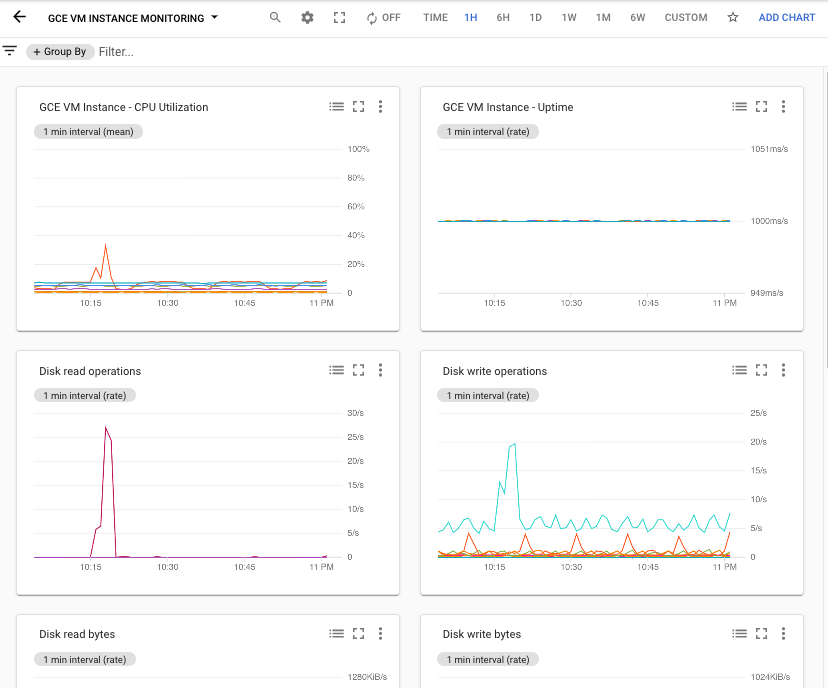Cloud Monitoring 在 GitHub 上提供一组精选的信息中心模板,专门用于各种 Google Cloud 服务,例如 Compute Engine、Cloud Storage、BigQuery 等。这些信息中心上的图表提供一系列与特定服务相关的指标。您可以使用 Cloud Monitoring API 或 Google Cloud 控制台在 Google Cloud 项目中将这些模板安装为自定义信息中心。
本页面介绍如何安装通过Google Cloud 控制台提供的模板,或存储在 GitHub monitoring-dashboard-samples 仓库中的模板。每个模板均存储为 JSON 文件。本页面还介绍了如何在Google Cloud 控制台中查看信息中心。
此功能仅适用于 Google Cloud 项目。对于 App Hub 配置,请选择 App Hub 宿主项目或已启用应用的文件夹的管理项目。
安装信息中心模板
Google Cloud 控制台
如需使用 Google Cloud 控制台安装信息中心模板,请执行以下操作:
-
在 Google Cloud 控制台中,前往
 信息中心页面:
信息中心页面:
如果您使用搜索栏查找此页面,请选择子标题为监控的结果。
在 Google Cloud 控制台的工具栏中,选择您的 Google Cloud 项目。对于 App Hub 配置,请选择 App Hub 宿主项目或已启用应用的文件夹的管理项目。
执行下列其中一项操作:
如需通过Google Cloud 控制台中提供的库安装模板,请执行以下操作:
- 点击信息中心模板。
- 找到要安装的信息中心。
- 可选:如需预览信息中心,请选择相应信息中心。
点击 playlist_add 将信息中心添加到您的列表,然后完成对话框。
您可以通过该对话框选择信息中心的名称,并向信息中心添加标签。
如需通过上传 JSON 文件安装信息中心,请执行以下操作:
可选:如需安装精选的信息中心模板,请下载 GitHub 仓库:
git clone https://github.com/GoogleCloudPlatform/monitoring-dashboard-samples.git
点击创建信息中心。
在信息中心工具栏中,依次点击 settings 设置和 JSON,然后选择 JSON 编辑器。
对于新的信息中心,显示的代码类似于以下内容:
{ "displayName": "New Dashboard", "mosaicLayout": { "columns": 12, "tiles": [] }, "dashboardFilters": [], "labels": {} }在编辑器的工具栏中,点击
上传文件。
选择包含模板的文件,然后点击打开。
文件上传后,信息中心的 JSON 即会被更新。
如果您看到以下消息:“无法保存信息中心:字段 mosaicLayout.tiles[0] 包含无效值”,请在信息中心工具栏中选择网格。
可选:自定义信息中心。例如,您可以更新标题、添加指示信息中心来源的文本 widget、删除不需要的图表或添加图表。
如需保存修改后的信息中心,请在工具栏中点击保存。
gcloud CLI
如需使用 Google Cloud CLI 安装信息中心定义,请执行以下操作:
确保本地系统可以访问信息中心定义。
对于存储在 GitHub 代码库中的信息中心,您可以保存特定信息中心,也可以下载整个代码库:
git clone https://github.com/GoogleCloudPlatform/monitoring-dashboard-samples.git确定要安装的信息中心。
例如,在 GitHub 代码库中,目录
monitoring-dashboard-samples/dashboards/compute包含名为gce-vm-instance-monitoring.json的文件。发出
gcloud monitoring dashboards create命令并提供信息中心的 JSON 表示形式。例如,如需安装信息中心
gce-vm-instance-monitoring.json,请发出以下命令:gcloud monitoring dashboards create --config-from-file=gce-vm-instance-monitoring.json --project=PROJECT_ID在运行上述命令之前,请替换以下内容:
- PROJECT_ID:项目的标识符。 对于 App Hub 配置,请选择 App Hub 宿主项目或已启用应用的文件夹的管理项目。
Cloud Monitoring API
如需使用 Google Cloud CLI 安装信息中心定义,请执行以下操作:
确保本地系统可以访问信息中心定义。
对于存储在 GitHub 代码库中的信息中心,您可以保存特定信息中心,也可以下载整个代码库:
git clone https://github.com/GoogleCloudPlatform/monitoring-dashboard-samples.git确定要安装的信息中心。
例如,在 GitHub 代码库中,目录
monitoring-dashboard-samples/dashboards/compute包含名为gce-vm-instance-monitoring.json的文件。调用
dashboards.create并提供信息中心的 JSON 表示形式。 在 API 调用中,父级是在其中创建合成监控工具的项目。 对于 App Hub 配置,请选择 App Hub 宿主项目或已启用应用的文件夹的管理项目。 此字段采用以下格式:projects/PROJECT_ID
如需了解详情,请参阅创建和管理信息中心。
查看安装的信息中心
代码库中的每个文件都会创建一个新的自定义信息中心。例如,文件 gce-vm-instance-monitoring.json 会创建一个标题为“GCE 虚拟机实例监控”的信息中心。 如需查看此信息中心,请执行以下操作:
-
在 Google Cloud 控制台中,前往
 信息中心页面:
信息中心页面:
如果您使用搜索栏查找此页面,请选择子标题为监控的结果。
- 在 Google Cloud 控制台的工具栏中,选择您的 Google Cloud 项目。对于 App Hub 配置,请选择 App Hub 宿主项目或已启用应用的文件夹的管理项目。
- 在信息中心列表中,点击“GCE 虚拟机实例监控”。如果您有许多信息中心,则可能需要针对自定义信息中心或新信息中心的名称进行过滤。
以下屏幕截图显示了已安装信息中心的一部分:

添加或移除用户定义的标签
标签可帮助您根据信息中心显示的内容类型来找到相应的信息中心。例如,您可以向显示生产系统相关信息的信息中心添加 prod 标签。同样,您也可以添加 staging 标签,以指明信息中心是显示有关暂存系统的信息。
您只能向自定义信息中心添加标签。当信息中心显示 为信息中心添加标签按钮时,您可以配置哪些标签应用于信息中心。
如需为自定义信息中心添加或移除用户定义的标签,请执行以下操作:
-
在 Google Cloud 控制台中,前往
 信息中心页面:
信息中心页面:
如果您使用搜索栏查找此页面,请选择子标题为监控的结果。
- 在信息中心列表中,找到相应信息中心,然后点击 为信息中心添加标签。
- 执行以下任一操作:
如需创建标签并将其添加到信息中心,请在创建新标签部分的文本框中输入标签的名称,然后点击创建并应用。
- 如需配置为信息中心添加哪些标签,请点击 arrow_drop_down 选择要应用的标签,选择相应标签,然后点击确定。
- 如需保存更改,请点击确认。
